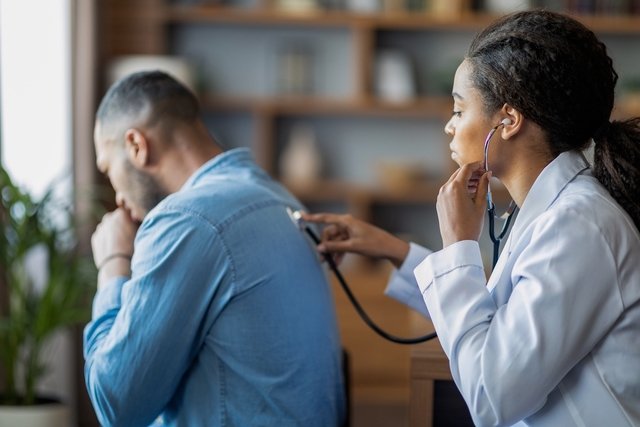Bacterial pneumonia is inflammation of the lungs caused by bacteria, which causes symptoms such as coughing with phlegm, fever and difficulty breathing, which appears after a flu or cold that does not go away or that worsens over time.
The main bacteria responsible for this type of pneumonia is Streptococcus pneumoniaehowever, other bacteria can also lead to the development of this infection, and it is important that they are identified so that the best treatment can be indicated by the doctor.
Bacterial pneumonia can be transmitted through sneezing and coughing up to two days after starting treatment, which can be carried out at home using antibiotic medications prescribed by your doctor. However, in some cases, it may be recommended by the pulmonologist or general practitioner that the treatment be carried out in the hospital, especially in the case of babies, children and older people.

Symptoms of bacterial pneumonia
The main symptoms of bacterial pneumonia are:
- Dry cough or cough with phlegm containing mucus, pus or blood;
- High fever, above 39º;
- Chills or excessive sweating;
- Difficulty breathing or shortness of breath;
- Chest pain when coughing or breathing;
- Nausea or vomiting;
- General malaise;
- Excessive tiredness.
In addition, other symptoms are headache or pain in muscles or joints, and mental confusion may also occur, especially in the elderly, over 65 years of age.
See with biomedical microbiologist Marcela Lemos how to recognize the symptoms of pneumonia:
How to confirm the diagnosis
The diagnosis of bacterial pneumonia is made by a pulmonologist or general practitioner through evaluation of symptoms, health history and physical examination by asking the person to breathe in and out, while listening to the lungs with a stethoscope, to check for noises during breathing.
To confirm the diagnosis, the doctor must request a chest X-ray or computed tomography to evaluate the lungs and which part is affected.
Make an appointment with a pulmonologist in the nearest region:
Taking care of your health has never been easier!
Other tests that may be ordered by the doctor are blood tests, such as a complete blood count or blood cultures, sputum test, bronchoscopy and pleural fluid culture, to identify the infection and which bacteria is causing the pneumonia.
Causes of bacterial pneumonia
The main bacteria related to bacterial pneumonia are:
- Streptococcus pneumoniae;
- Klebsiella pneumoniae;
- Staphylococcus aureus;
- Haemophilus influenzae;
- Legionella pneumophila;
- Mycoplasma pneumoniae.
It is important that the bacteria responsible for the infection is identified, as this means that the most appropriate and targeted treatment for the infectious agent can be carried out.
How transmission happens
The transmission of bacterial pneumonia is very difficult and, therefore, the patient does not infect healthy people. It is usually more common to get bacterial pneumonia due to the accidental entry of bacteria into the lungs from the mouth or from another infection somewhere in the body, by choking on food or due to a worsening of the flu or cold.
Furthermore, bacterial pneumonia can occur as a consequence of decreased immunity, which causes bacteria naturally present in the respiratory tract to proliferate and lead to infection and inflammation of the lungs, characterizing bacterial pneumonia.
This type of pneumonia is more common in children and the elderly, as they have a more fragile immune system, and people who have lung diseases, such as asthma, emphysema and COPD, for example.
How the treatment is carried out
The treatment of bacterial pneumonia must be carried out under the guidance of a pulmonologist or general practitioner and can be done at home with rest and the use of antibiotics for 7 to 14 days, according to medical recommendations.
However, in some cases, the doctor may recommend that the treatment be complemented with daily respiratory physiotherapy sessions to remove secretions from the lungs and facilitate breathing.
In more serious cases, when pneumonia is at a more advanced stage or in the case of babies and the elderly, it may be necessary to be admitted to the hospital to receive antibiotics directly into the vein and receive oxygen. See more details on the treatment for bacterial pneumonia.
Bibliography
- AMERICAN LUNG ASSOCIATION. What Causes Pneumonia?. Disponível em: <https://www.lung.org/lung-health-diseases/lung-disease-lookup/pneumonia/what-causes-pneumonia>. Acesso em 26 jul 2023
- ASHBY, T.; et al. Bacterial pneumonia infection in pregnancy. Best Pract Res Clin Obstet Gynaecol. 85. Pt A; 26-33, 2022
- GRIEF, S. N.; LOZA, J. K. Guidelines for the Evaluation and Treatment of Pneumonia. First Care. 45. 3; 485-503, 2018
- DE BENEDICTIS, FM; et al. Complicated pneumonia in children. Lancet. 396. 10253; 786-798, 2020
- SATTAR, S. B. A.; SHARMA, S. IN: STATPEARLS (INTERNET). TREASURE ISLAND (FL): STATPEARLS PUBLISHING. Bacterial Pneumonia. 2022. Available at: <https://www.ncbi.nlm.nih.gov/books/NBK513321/>. Accessed on 04 Jul 2023
- HENIG, O.; KAYE, K. S. Bacterial Pneumonia in Older Adults. Infect Dis Clin North Am. 31. 4; 689-713, 2017
- BROADDUS, V. Courtney. et al. Murray & Nadel treatise on respiratory medicine. 6.ed. Rio de Janeiro: Elsevier, 2017.
- VILAR, Fernando C. Continuing Medical Education Program – Pneumonia. Available at: <http://www.cremesp.org.br/pdfs/eventos/eve_04102016_145915_Pneumonias%20-%20Dr.%20Fernando%20Crivelenti%20Vilar.pdf>.
- CORRÊA, Ricardo A. et al. Recommendations for the management of community-acquired pneumonia 2018. Brazilian Journal of Pulmonology. Vol 44. 5 ed; 405-424, 2018

Sign up for our newsletter and stay up to date with exclusive news
that can transform your routine!
Warning: Undefined array key "title" in /home/storelat/public_html/wp-content/plugins/link-whisper-premium/templates/frontend/related-posts.php on line 12
Warning: Undefined array key "title_tag" in /home/storelat/public_html/wp-content/plugins/link-whisper-premium/templates/frontend/related-posts.php on line 13




